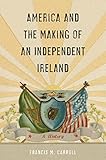America and the making of an independent Ireland : a history / Francis M. Carroll.
Series: The Glucksman Irish diaspora seriesPublisher: New York : New York University Press, 2021Description: xii, 291 pp. : ill., ports. ; 24 cmISBN:- 9781479805655 : (hbk.)
- Nationalism -- Ireland -- History -- 20th century
- Irish question
- International relations -- Ireland
- United States -- Foreign relations -- Ireland. -- 20th century
- Ireland -- Foreign relations -- United States
- Ireland -- Politics and government -- 1910-1921
- Ireland -- Politics and government -- 1922-1949
- 327.415 23
| Item type | Current library | Collection | Call number | Status | Date due | Barcode |
|---|---|---|---|---|---|---|
| Loanable Book | Library | Irish Collection | 327.415 CAR (Browse shelf(Opens below)) | Available | 000437394 |
Includes bibliographical references and index.
Changed, Changed Utterly -- America and the Irish Rising of 1916 -- America, the War Crisis, and the Irish Problem, 1916-1918 -- The 1919 Paris Peace Conference, the American Commission on Irish Independence, and Self-Determination for Ireland -- Money: The Sinews of War, 1919-1921 -- Ireland in the Eye of Public Opinion: The American Commission on Conditions in Ireland, 1920-1921 -- American Aid for Ireland, 1920-1922 -- The Emergence of the Irish Free State and American Diplomatic Recognition, 1921-1927 -- President William T. Cosgrave Comes to the United States, 1928 -- Secretary of State Frank B. Kellogg Comes to Ireland, 1928 -- Ireland and America.
Examines how the Irish American community, the American public, and the American government played a crucial role in the making of a sovereign independent Ireland
On Easter Day 1916, more than a thousand Irishmen stormed Dublin city center, seizing the General Post Office building and reading the Proclamation for an independent Irish Republic. The British declared martial law shortly afterward, and the rebellion was violently quashed by the military. In a ten-day period after the event, fourteen leaders of the uprising were executed by firing squad.
In New York, news of the uprising spread quickly among the substantial Irish American population. Initially the media blamed German interference, but eventually news of British-propagated atrocities came to light, and Irish Americans were quick to respond.
America and the Making of an Independent Ireland centres on the diplomatic relationship between Ireland and the United States at the time of Irish Independence and World War I. Beginning with the Rising of 1916, Francis M. Carroll chronicles how Irish Americans responded to the movement for Irish independence and pressuring the US government to intervene on the side of Ireland. Carroll’s in-depth analysis demonstrates that Irish Americans after World War I raised funds for the Dáil Éireann government and for war relief, while shaping public opinion in favor of an independent nation. The book illustrates how the US government was the first power to extend diplomatic recognition to Ireland and welcome it into the international community.
Overall, Carroll argues that the existence of the state of Ireland is owed to considerable effort and intervention by Irish Americans and the American public at large. Provided by publisher.

There are no comments on this title.